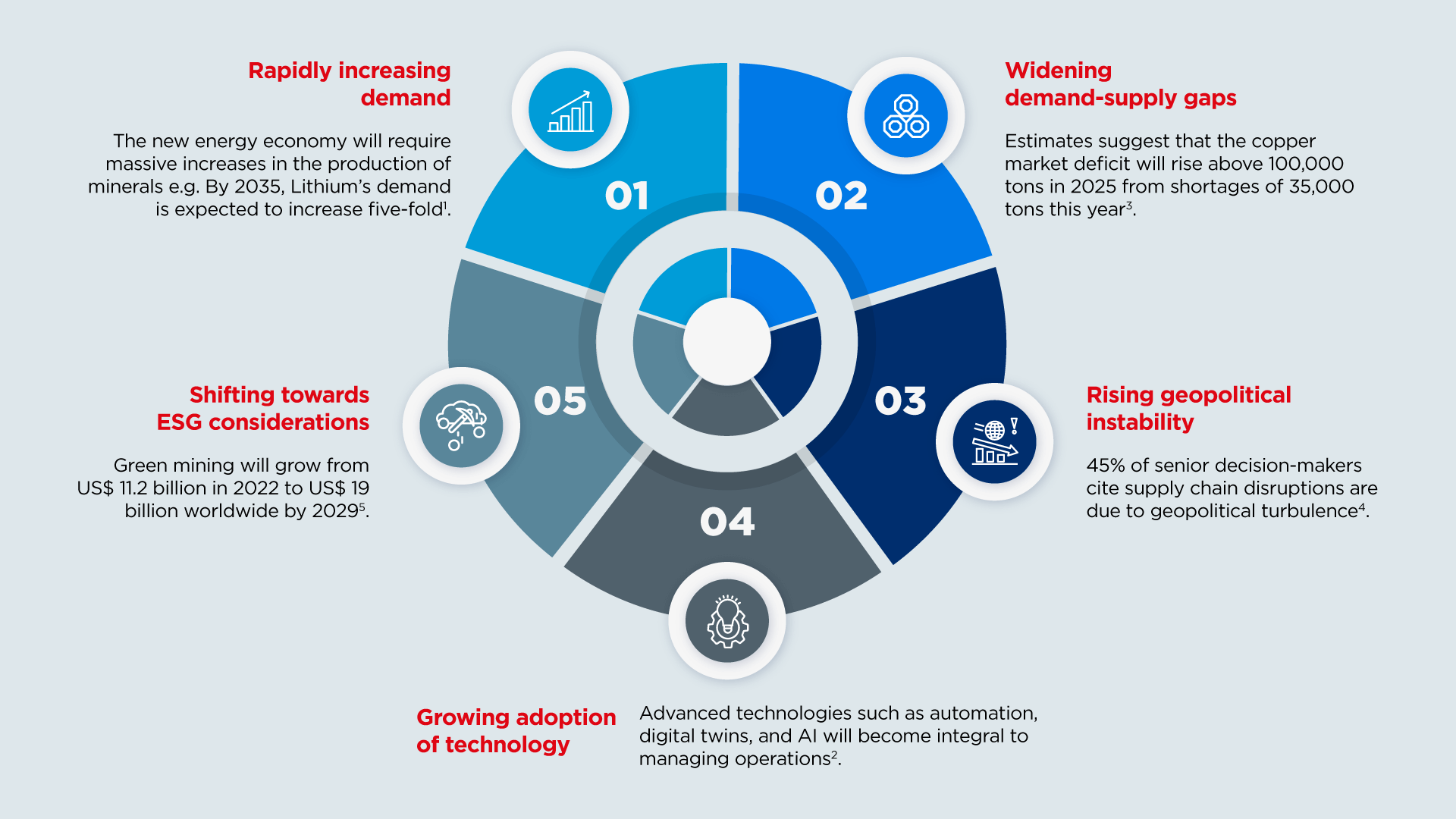Beyond Extraction: Mining and the Road to Net Zero
Trends, challenges, and the vital role of integrated supply chain planning
The mining industry holds the keys to a net-zero future. Leading sector experts expect a surge in demand for vast quantities of raw materials to support the shift towards cleaner technologies1. However, demand for critical minerals is already outstripping supply. To bridge the gap, producers will have to expand their operations, complicating an intricate supply chain.
Despite their necessity for the energy transition, producers will also be scrutinized for their sustainability practices. From erosion and air and water pollution to affecting biodiversity, the industry is a major polluter2. How will producers match demand in an environmentally friendly way? This article explores how integrated mining operations planning is essential to addressing producers’ complex challenges, enabling them to balance their operational, financial, and sustainability goals.
By the numbers: The evolving dynamics in mining


Beyond the ore: Producers’ mounting challenges
The mining industry, while indispensable for powering global decarbonization, is not without its trials. Its multifaceted nature and global supply chain exposes it to a wide range of challenges that span economic, operational, environmental, and regulatory spheres.
Economic volatility and uncertainty
The sector is inherently susceptible to economic fluctuations. Commodity prices, subject to the whims of international markets, can swing dramatically, impacting profitability. Producers must grapple with the evolving demands of sustainability, shifting customer preferences, and fierce competition. The uncertainty extends to factors like fluctuating operational costs and unforeseen disruptions, creating a complex economic landscape for the mining supply chain.
The pursuit of operational efficiency
Efficiency in mining encompasses a broad spectrum, from reducing costs and enhancing technical capabilities to eliminating wasteful practices and meeting customer expectations. As companies strive to optimize their operations, they face the challenge of balancing these diverse factors to maintain competitiveness in a ever-evolving market.
Navigating a landscape of risk
Mining is fraught with inherent risks stemming from volatile geological instability, mineral prices, intricate supply chains, and stringent regulatory frameworks. Disruptions can arise from unexpected sources, creating a constant need for vigilance and adaptability. The complexity of risk management is compounded by the need to align risk mitigation strategies with broader sustainability objectives, a challenge that requires meticulous planning and execution.
The environmental imperative
Unplanned and inefficient mining operations can lead to ecological degradation, including soil erosion, waste accumulation, air and water pollution, and habitat destruction. Organizations are also challenged to balance resource extraction with conservation efforts. This necessitates a fundamental shift toward sustainable practices, driven by technological innovation, regulatory compliance, and a growing commitment to social responsibility.
This overview merely scratches the surface of the intricate challenges faced by mining organizations and their supply chains. However, it highlights the dynamic and complex nature of this vital sector, which must constantly adapt and innovate to meet the demands of a changing world.
Untangling complexity: Supply chain planning in mining

To bridge the potential demand-supply gap sustainably, producers must balance their financial, operational, and environmental goals now. It is not a simple case of flipping a switch. They must look at their processes and identify opportunities to boost efficiency and manage disruptions. This is because an agile and resilient supply chain will be crucial in reducing inefficiencies that could cripple the energy transition1. Here’s a breakdown of supply chain operations:
Capacity planning: Balancing expansion and environmental impact
Capacity planning is a cornerstone of the mining supply chain, linking the network of mines (both owned and third-party), inventory control, and processing facilities. It involves strategic decisions with far-reaching consequences, such as infrastructure expansion. While crucial for meeting growing demand, such expansion can have significant environmental repercussions, including construction waste, carbon emissions, and habitat disruption. Balancing the need for increased capacity with environmental concerns requires careful consideration of long-term sustainability goals.
Production scheduling: Orchestrating complex decisions
Production scheduling is the intricate process of making critical decisions regarding minerals selection, extraction sequencing, processing, stockpiling, and transporting ore while adhering to a multitude of constraints. Mining companies must determine the optimal sequence of operations to maximize revenue or minimize costs, considering factors like equipment availability, workforce limitations, geological uncertainties, and safety regulations. Geological uncertainties, such as variations in ore grade, add another layer of complexity. Different ore grades require different processing techniques to achieve a consistent product, making optimal blending of ores essential. This need for consistency adds to the significant planning challenge. Effective production scheduling is essential for ensuring efficient resource utilization, minimizing downtime, and meeting production targets.
Inventory control: Taming the bullwhip effect
The industry’s inherent uncertainties, coupled with the bullwhip effect – the amplification of demand variations along the supply chain – can lead to either costly overstocking or disruptive understocking. The quality of extracted materials can also degrade over time, further complicating inventory control. Finding the optimal balance between minimizing costs and ensuring a steady supply of materials requires sophisticated planning models that account for demand fluctuations, material degradation, and the intricacies of the distribution network.
Logistics planning: The intricate dance of transportation
The journey of extracted materials from mine to port to end-user is a complex logistical ballet. Mining companies must grapple with a myriad of transportation modes (railways, roads, waterways), each with its own capacity constraints and environmental footprint. The challenge lies in optimizing routes, minimizing congestion, and reducing transportation costs while ensuring the timely delivery of materials. Additionally, there is the added complication of processing ores at the right time, sometimes even during transit to prevent decay of ore quality. This intricate dance of logistics requires careful coordination and a holistic view of the entire supply chain.
Together, these planning challenges form a complex puzzle that mining companies must solve to thrive in a rapidly changing world. The key lies in adopting a holistic approach that integrates all aspects of the supply chain, leverages data and technology, and prioritizes sustainable practices. With end-to-end integrated mining operations planning, the industry can truly unlock its potential to meet the growing demand for minerals and boost profitability while minimizing its environmental impact.
But what’s holding it back?
The culprit: Siloed planning
Let’s face the truth, mining corporations may not be ready to overcome these challenges or solve their planning puzzle. Why? It’s because they’re knee-deep in siloed planning.
Siloed planning refers to the situation where different departments or functions operate independently, without effective communication or coordination. Each one focuses on optimizing its own operation, often with little regard for the impact on other parts of the supply chain. They work not only in departmental (and sometimes local) silos but also informational silos, hampering communication and coordination. The reason for the formation of silos is simple: to break down the complexity of the supply chain. Mining operations are inherently complex, and it appears logical to chop up a big problem into smaller, more manageable problems. The idea is that the smaller ones are easier to solve, and by solving them one by one, the larger problem will be addressed.
However, this approach is based on some flawed assumptions:
- Assumption 1: A larger problem can be effectively broken down into smaller, isolated problems.
- Assumption 2: Solving these smaller problems independently will significantly alleviate the larger issue.
We’ve observed that these assumptions often fail when disruptions occur.
Consider a mining operation represented in the image (below), involving several stages: mines, ports, blending facilities, smelter, processing plant, and finally products and by products. Suppose a disruption occurs, such as a breakdown at a blending facility. When these departments operate in silos, there’s a delay in obtaining and acting on relevant information. The mines may continue extracting ore at full capacity, aware of the bottleneck but unable to adjust plans efficiently. This leads to an excessive buildup of raw ore at the port, causing storage issues and increased costs. Meanwhile, the smelter and processing plant, despite knowing about the problem, cannot efficiently redirect resources or adjust schedules, resulting in wasted resources and scheduling conflicts.


The lack of communication and coordination among stages leads to inefficiencies and increased operational costs. By adopting a more integrated approach, mining companies can improve their supply chain efficiency, reduce costs, and enhance customer satisfaction.
Integrated mining operations planning: The key ingredients
The critical elements to truly integrating the supply chain depend on:
- Visibility: Organizations that improve their operational visibility can achieve greater control, which enhances efficiency and reduces costs. This improved oversight often boosts sales performance and cost management, leading to increased profitability6. Eliminating data silos ensures cohesive information flow, improving communication and decision-making. This coordination streamlines operations, reduces delays, and boosts productivity.
- Collaboration: Closer collaboration among departments and stakeholders optimizes financial strategies, demand forecasting, and inventory control. Working together ensures alignment towards common goals, reducing overproduction, minimizing stockouts, and maintaining optimal inventory levels.
- Technology: Utilizing advanced technologies improves technical efficiency and cost-effectiveness, enhancing competitiveness7. Implementing dynamic inventory control tools and Advanced Planning and Scheduling (APS) systems helps maintain optimal inventory levels, reduce costs, identify optimal warehouse locations, and optimize production and transportation schedules.
By incorporating visibility, collaboration, and technology, organizations can create a more integrated and efficient supply chain, leading to improved efficiency, reduced costs, and enhanced profitability.
A partner to help
The results of integrating your supply chain are undeniable. However, ensuring your people, processes, and technology are set up for success is not an easy task. Moving to a new way of planning requires careful change management. Your planners’ buy-in is crucial to reaping the benefits of adopting state-of-the-art technology. Furthermore, enterprise software implementation can be a long, drawn out process without the right technical knowledge and expertise.
That’s where we can help. The Logic Factory is a global supply chain planning and optimization consultancy company, whose mission is to help you make lasting performance improvements and realize value within your operations. Our planning experts have worked with natural resource and mining companies around the world, leading them toward profit maximization sustainably. In fact, we have supported this global leader reduce the impact of volatile market conditions by empowering their planners with the tools that offer greater visibility and planning optimization.
The success of the energy transition lies in your hands. Will you seize this opportunity to transform, embracing the new era of efficiency, resilience, and environmental stewardship?
References
1 World Economic Forum. (2023, December 18). Securing minerals for the energy transition. https://www.weforum.org/publications/securing-minerals-for-the-energy-transition/
2 Zeng, L., Liu, S. Q., Kozan, E., Corry, P., & Masoud, M. (2021). A comprehensive interdisciplinary review of mine supply chain management. Resources Policy, 74, 102274. https://doi.org/10.1016/j.resourpol.2021.102274
4 White & Case LLP. (2024). Mining & metals 2024: Geopolitics in the driver’s seat. White & Case LLP. https://www.whitecase.com/insight-our-thinking/mining-metals-2024-geopolitics-drivers-seat
5 Statista. (2023). Size of the green mining market worldwide from 2019 to 2027. https://www.statista.com/statistics/1100778/global-green-mining-market-size/
6 Swift C, Guide Jr. VDR, Muthulingam S. Does supply chain visibility affect operating performance? Evidence from conflict minerals disclosures. J Oper Manag. 2019; 65: 406–429. https://doi.org/10.1002/joom.1021
7 Budeba, M.D., Joubert, J.W., Webber-Youngman, R., Shafiee, S., 2017. Predicting the efficiency of a surface coal mine for competitiveness. Int. J. Mining, Reclam. Environ. 31, 187–204. https://doi.org/10.1080/17480930.2015.1135669






